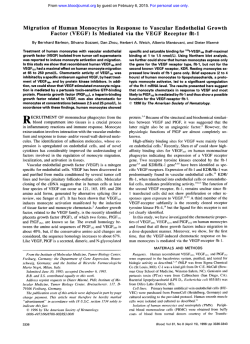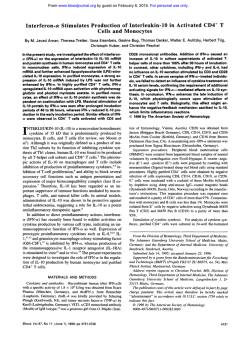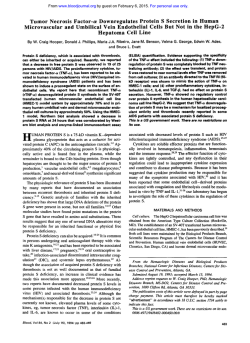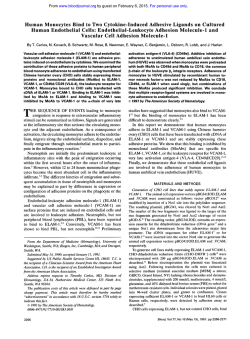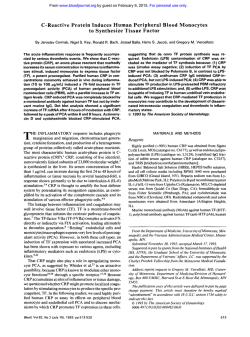
Differential Cytokine Expression in Human Blood Monocyte
From www.bloodjournal.org by guest on February 6, 2015. For personal use only. Differential Cytokine Expression in Human Blood Monocyte Subpopulations: A Polymerase Chain Reaction Analysis By Marion Frankenberger, Thomas Sternsdorf, Heinrich Pechumer, A. Pforte, and H.W. Loms Ziegler-Heitbrock The subpopulation of strongly CDl4-positive (CD14++) monocytes and monocytes coexpressing the CD16 antigen and low levels of CD14 (CD14+/CD16+ cells) were isolated by fluorescence-activated cell sorting (FACS) followed by stimulation with lipopolysaccharide (LPS) at 1 pg/mL. Polymerase chain reaction (PCR) after reverse transcription of isolated mRNA (RT-PCRI revealed similar levels of tumor necrosis factor (TNF) transcripts in both subpopulations. By contrast, transcripts for interleukin-10 (IL-10) were only detectable in CD14++ monocytes, whereas CD14+/CD16+ cells produced no detectable IL-10 transcripts after 4 hours. Only after 16 hours of LPS stimulation was a low level of IL-10 transcripts discernible in CD14+/CD16+ monocytes. The same pattern was seen at the protein level in that TNF in LPS-stimulated supernatants was comparable for both sub- populations, whereas IL-10 was detected in CD14++ monocytes but not in CD14+/CD16+ cells. To avoid interference of cell activation by CD14 and CD16 antibodies, cells were also isolated based on the high and low level of CD33 antigen expression. Again, weakly CD33-positive cells, which comprise the CD14+/CD16+ cells, showed no or only minimal IL10 mRNA. When comparing blood monocyte subpopulations with alveolar macrophages (AM), AM showed high levels of LPS-stimulated TNF, whereas IL-10 transcripts were undetectable. Our data show that CD14+/CD16+blood monocytes produce high levels of proinflammatory cytokines like TNF, whereas the anti-inflammatory IL-10 is low or absent, a pattern similar to what is seen in AM. 0 7996 by The American Society of Hematology. H Isolation of AM. Bronchoalveolar lavage was performed according to routine procedures in apparently healthy donors after informed consent had been obtained. The study was approved by the Ethics Committee of the University of Munich. Immunojuorescence and cell sorting. Separated monocytes or mononuclear cells were then stained for 30 minutes at 4°C in 0.5mL vol with the anti-CD14 antibody My4-fluorescein conjugate (Coulter, Krefeld, Germany) and the anti-CD16 antibody Leu1 lcphycoerythrin conjugate (Becton Dickinson, Heidelberg, Germany) under saturating conditions. For some experiments, cells were only stained with the anti-CD33 antibody My9 (Coulter) and goat-antimouse FITC as detection antibody. Cell sorting of the stained cells was performed with an EPICS V 753 flow cytometer (Coulter) with 488-nm excitation. Purities were more than 90% for both subsets as determined by re-analysis. After sorting, cells were either immediately lysed with 200 pL RNAzol B (WAK-Chemie, Bad Homburg, Germany) at a concentration of 2 x IO4 cells per aliquot or stimulated with LPS (10 ng/mL to 1 pg/mL) in RPMI1640 with 10% fetal calf serum for another 4 to 16 hours and then lysed in RNAzol B at the same concentration. The lysates were stored at -20°C. RT-PCR. Quantitative PCR for TNF mRNA was performed with an internal cRNA standard according to the method of Wang et al.’4 After cell lysis, 5 to 10 x IO5 copies of the cRNA standard (pAW109; Perkin Elmer Cetus, Uberlingen, Germany) and 14 pg transfer RNA as carrier were added per sample. PCR for IL-IO mRNA was performed in the same manner without internal standard, but using the same RNA as for TNF PCR. After isolation, the RNA was reverse-transcribed with oligo(dT) as primer. PCR amplification ETEROGENEITY of human blood monocytes was suggested by earlier studies that demonstrated some functional differences for fractions with different sedimentation beha~i0r.I.~ However, research on such subsets was hampered by the fact that they could not be isolated as pure populations, no markers were available to clearly distinguish them, and they could not be enumerated. We recently identified a novel subpopulation of monocytes that coexpress CD16 (Fcy receptor 111) and low levels of CD14 (receptor for lipopolysaccharide [LPS]). These CD14+/CD16+ cells can be distinguished from the major population of strongly CD14-positive (CD14++)monocytes, which are CD16-.6,7 CD14’/CD16’ cells were shown to be more mature and to resemble alveolar macrophages (AM).’ Furthermore, they were found to be increased in sepsis patients and in patients with human immunodeficiency virus infection.’-’ Earlier functional studies indicated that these cells had a generally lower level of cytokine production,” and similar data were obtained by others who examined populations enriched for CD14+/CD16’ cells by ~edimentation.’~ Our earlier results were obtained with cells subjected to lengthy gradient separation, elutriation, and fluorescence-activated cell sorting (FACS) separation. With the advent of reverse transcriptasepolymerase chain reaction (RT-PCR) technology for analysis of mRNA levels, it became feasible to perform such studies on low numbers of cells that could be obtained within a few hours. Using this approach, we now show that CD14’1 CD16’ cells are in fact capable of producing proinflammatory cytokines like tumor necrosis factor (TNF). However, expression of the antiinflammatory cytokine interleukin-10 (IL-10) is consistently minimal or absent. This suggests that CD14+/CD16+cells may serve a function as efficient immunostimulatory and proinflammatory monocytes. MATERIALS AND METHODS Isolation of monocytes. Four hundred-milliliter volumes of peripheral blood were drawn from apparently healthy donors and defibrinated with the aid of glass beads. Monocytes were then isolated under LPS-free conditions by Nycohep density gradient (1.068 specific density, W9506020; Nycomed Oslo, Norway) according to the manufacturer’s instruction. In some experiments, we used mononuclear cells isolated by Ficoll-Hypaque density-gradient separation. Blood, Vol 87, No 1 (January 1). 1996:pp 373-377 From the Institute f o r Immunology, and the Department of Internal Medicine, Klinikum Innenstadt, University of Munich, Munich, Germany. Submitted April IO, 1995; accepted August 23, 1995. Supported by grants from Deutsche Forschungsgemeinschaji (SFB 21 7) and from the Verum Foundation, Miinchen, Germany. Address reprint requests to H.W. Liims Ziegler-Heitbrock, MD, Institute f o r Immunology, University of Munich, Goethestr 3 I , 80336 Miinchen, Germany. The publication costs of this article were defrayed in part by page charge payment. This article must therefore be hereby marked “advertisement” in accordance with I8 U.S.C. section 1734 solely to indicate this fact. 0 1996 by The American Society of Hematology. 0006-4971/96/87OI-0015$3.00/0 373 From www.bloodjournal.org by guest on February 6, 2015. For personal use only. FRANKENBERGER ET AL 374 was performed with the gene Amp RNA-PCR kit (#N8080017; Perkin Elmer Cetus). Thirty-five to 38 cycles for TNF or 45 cycles of amplification for IL-IO were performed with a Hybaid Thermal Reactor (model HBTRI; Biometra, Gottingen, Germany) with sets of 1 minute at 94°C. I minute at 59°C. and 40 seconds at 72°C. The PCR product was separated on a 1.4% (TNF) or 2% (IL-IO and pactin) agarose gel containing ethidium bromide. Polaroid photographs with UV exposure were taken with 4 x 5 Polaroid film (F4388; Sigma, Deisenhofen, Germany). The positive was used for presentation, whereas the negative, after development with sodium bisulfite (18%wt/vol, S-9OOO; Sigma), was used for laser densitometry. The following primers were used: TNF, 5'-primer, 5' CAG AGG GAA GAG TTC CCC AG 3'. and 3'-primer, 5' CCT TGG TCT GGT AGG AGA CG 3'; IL-Ip, 5'-primer, 5' AAA CAG ATG AAG TGC TCC TTC CAG G 3'. and 3'-primer, 5' TGG AGA ACA CCA CTT GTT GCT CCA 3'; IL-6, 5'-primer, 5' ATG AAC TCC TTC TCC ACA AGC 3'. and 3'-primer, 5' CTA CAT TTG CCG AAG AGC CCT CAG GCT GGA CTG 3'; IL-IO, 5'-primer, 5' ATG CCC CAA GCT GAG AAC CAA GAC CCA 3'. and 3'-primer, 5' TCT CAA GGG GCT GGG TCA GCT ATC CCA 3'; and &actin, 5'-primer, 5' GTG GGG CGC CCC AGG CAC CA 3', and 3'primer, 5' CTC CTT AAT GTC ACG CAC GAT TTC 3'. Assaysfor cytokine protein. For determination of TNF and IL10 protein, 2 X IO5 cells were stimulated with LPS ( I pg/mL) in 400 p L of RPMI 1640 with 10% fetal calf serum, and supernatants were harvested after 4 hours. TNF protein was determined in serially diluted 100-pL vol using the Wehi 164lActinomycin D bioassay with reference to a recombinant TNF standard (IO' Ulmg) as previously described." IL- 10 protein was determined by an enzyme-linked immunosorbent assay kit (Dianova, Hamburg, Germany) according to manufacturer's instructions. Statistical analysis was performed with Student's r-test. RESULTS Two-color immunofluorescence analysis of human blood monocytes defines a population of CD14++cells and a popu- C D14+/CD16+ u l 4 a U 0 LPS +U + 2 a + U \ + 4 CI + ? + e -n t -- i ?NF\ Standard Fig 2. PCR analysis for TNF mRNA in monocyte subpopulations. FACS-purified subpopulations (>94% purity) were either left untreated or cultured for 2 hours with LPS (10 ng/mL). Cells were lysed, cRNA standard was added, and purified RNA was reverse-transcribed and then amplified by PCR. Densitometry for the upper band specific for endogenous TNF gave 30.6 and 33.4 arbitrary units for LPS-treated CD14" and CD14'/CD16' cells, respectively (1representative of 9 experiments). lation with coexpression of CD14 and CD16 (CD14'/CD16' cells) (Fig I). In an average of 19 experiments, these CD14'/ CD16' cells accounted for 18% 2 4% (mean 2 SD) of all monocytes. For analysis of cytokine expression, these two subsets were isolated to more than 90% purity by FACS and cultured with or without LPS at 1 &mL for 4 hours. Cell samples were lysed with RNAzol, and after addition of cRNA standard, RNA was isolated and reverse-transcribed and PCR was performed with primers specific for TNF. A representative example in Fig 2 demonstrates minimal or no transcripts in unstimulated monocyte subpopulations, whereas a strong band is visible for the internal standard. LPS-stimulated cells showed a high level of TNF transcripts for both CD14" and CD14'/CD16' cells, whereas the internal standard was competitively reduced. Comparable levels of TNF transcripts were also obtained with low levels of LPS ( I O ng/mL, data not shown). PCR analysis of IL-1 and IL-6 mRNA levels also gave similar values for both subpopulations (Table 1). When the same samples were subTable 1. mRNA Levels for Cvtokines in Monocvte SUbDoDUlatiOnS mRNA Level CD14" (96 of arbitrav units) No. of CDl4 Fig 1. T w o t o l o r immunofluorescence analysis of blood monocyte subpopulations. Isolated monocytes were stained with CD14FITC and CD16 phycoerythrin and analyzed by FACS. CD14" regular monocytes were 45% and double-positive CD14'/CD16' cells were 18% in this example. Cytokine Experiments TNF IL-18 IL-6 IL-10 9 4 4 7 CD14" CD14*/CD16' 100 100 100 100 106 2 26 94 t 6 101 2 3 0 Cell sorter-purified populations were stimulated with LPS at 1 p g l mL for 4 hours and mRNA was reverse-transcribed and amplified by PCR, followed by agarose gel electrophoresis and laser densitometry. Arbitrary units obtained for CD14" monocytes were set at 100%. Values for CD14'/CD16' are the mean z SD. From www.bloodjournal.org by guest on February 6, 2015. For personal use only. CYTOKINES IN MONOCYTE SUBPOPULATIONS jected to PCR for IL-IO, only CD14" cells exhibited a signal, whereas CD14'/CDI 6' cells were negative at 4 hours (Fig 3). To exclude that CD14'/CD16' cells simply show slower kinetics for IL- I O mRNA induction, cells were tested after 16 hours. These analyses showed a further increased level of IL-IO mRNA prevalence in CD14" cells. In some experiments, a weak signal was discernible in CD14'/CD16' cells at this point in time (not shown). A similar pattern was seen when looking at cytokine protein with comparable TNF levels and low IL-IO values in CD14+/CD16' monocytes. Here, TNF values were 244 2 101 U/mL for CD14" cells and 525 2 124 U/mL for CD14'/CDI 6' cells (not significant). Levels of IL- IO protein were 27.2 5 1 1.2 pg/mL for CD14", whereas no IL- IO was detectable in CD14'/CD16' cells (n = 3). To exclude the possibility that the CD14 antibody, which is used for identification and isolation of monocyte subsets, does block LPS action and thereby prevents production of IL-IO, we isolated the subsets by a different strategy. For this, we exploited the fact that regular CD14" cells show high levels of CD33 (CD33"), whereas CD14'/CD16' cells CD33' CD33" CD33 LPS 4h 0 +us +us T F n ++ w r n u u + \ w r n u n LPS 16h +\o r Fig 4. Isolation of monocyte subpopulation based on CD33 antigen density. Cells were FACS-separatedbased on high or low antigen density. Test samples were controlled by additional staining with anti-CD16. Isolated CD33' cells were 50% CD16' and CD33" cells were 8% CD16' in this example. n u + \ w .- n u Fig 3. PCR analysis for IL-10 mRNA in monocyte subpopulations. FACS-purified subpopulations (>97% purity) were either left untreated or cultured for 4 or 16 hours with LPS (1 pg/mL). RNA was purified, reverse-transcribad, and amplified by PCR (1 representative of 7 experiments].Densitometryfor stimulated 14" cells gave values of 37.3 for 4 hours and 62.5 for 16 hours, whereas no signal was evident for 14'/16' cells. exhibit only low CD33 levels (CD33"). Sorting was performed with gates as in Fig 4. When test samples of the resultant populations were stained with CD16, only 8% of CD33" cells were CD16'. whereas the CD33" fraction contained 50% CD16' cells. These isolated cells that had been exposed only to CD33 antibody were then stimulated with LPS, and transcript levels were determined by PCR. Figure 5 demonstrates that CD33" cells, which represent CD 14" regular monocytes, show high transcript levels for IL-10 at 4 and 16 hours. By contrast, CD33' cells, which comprise the CD14+/CD16' monocytes, had no or only minimal levels of IL-IO mRNA. Furthermore, when 14'/16' and 14" cells were isolated by FACS directly from FicollHypaque-purified mononuclear cells instead of NycoPrepenriched monocytes, CD14'/CDI 6' cells also showed more than ninefold lower IL-IO mRNA levels (n = 2, data not shown). These data show that CD14'/CD16' monocytes are in fact incapable of producing significant amounts of IL-10 mRNA. In previous studies, we have demonstrated that CD14'/ CD 16' monocytes share several phenotypic properties with AM. We have therefore asked if this similarity extends to functional properties like cytokine production. For this purpose, bronchoalveolar lavage cells from healthy donors were isolated and compared with CD14" and CD14'/CD16' blood monocytes from the same donor. Figure 6 demonstrates that LPS-stimulated AM produce TNF transcripts at levels comparable to blood monocytes. However, IL- IO production was absent in AM, with or without CD14 staining From www.bloodjournal.org by guest on February 6, 2015. For personal use only. 376 FRANKENBERGER ET AL and cell sorting. Hence, AM and CD14'/CD16' cells are similar also with respect to the pattern of cytokine production. LPS fa w DISCUSSION I- Early studies on monocyte subpopulations have revealed that fractions containing somewhat smaller cells exhibit lower reactive oxygen production and higher antigen presentation ~apacity.'.~.~ Furthermore, more dense monocytes were found to exhibit higher cytokine production.' However, isolation of subpopulations by such sedimentation procedures did not result in clearly separated pure subsets. Furthermore, subpopulations could not be enumerated as can be done with cell-surface markers. We have recently identified the novel subset of blood monocytes that coexpress CD14 and CD16 antigens. These CD14+/CD16' cells account for about 10% of all blood monocytes." When compared with CD14" monocytes, CD14'/CD16+ cells exhibit lower phagocytosis capacity and H202production,' and show lower levels of CDI Ib and CD33 and higher levels of MHC class 11.' In previous studies on cytokine production, we found that CD I4'/CDI 6' monocytes generated lower levels of the cy- f Y 0 v, r' Q: ++ 3 d CI 0 TNF 11-10 L P S 4h L P S 16h Oh ++ + ++ + ++ + " " " " " " n a n n n n U U V U U U IL-IO Fig 6. Comparison of cytokine production in blood monocyte subpopulations and AM. FACS-purified subpopulations (>90% purity) and AM from the same donor (either without or with CD14 staining and cell sorting) were stimulated for 4 hours with LPS (1 pglmL). Cells were lysed, and mRNA was isolated and amplified by PCR (1 of 3 experiments). tokines TNF, IL-I, and IL-6. Similar results were obtained by Wang et al," who reported lower levels of TNF and ILI in slow-sedimentation fractions of cells that were characterized by lower CD14 and lower C D l l b expression. We now report that CD 14'/CD 16' monocytes and CD 14' cells show comparable levels of TNF, IL-1, and IL-6. The reasons for the discrepancy between these previous studies and the results presented herein are unclear, but it may be that CD14'/CD16' monocytes are more sensitive to physical alterations inflicted on them during isolation. This may not lead to cell death, but could lead to impaired responsiveness. Our previous approach included density-gradient isolation, elutriation, and cell sorting, which altogether required more than 24 hours to obtain lo6 cells. Our current procedure involves only one gradient separation followed by flow cytometry sorting for a few hours to obtain only the IO5 cells that are sufficient for RT-PCR analysis. Although analysis in such cells revealed efficient production of the cytokines TNF, IL-I, and IL-6 at the transcript level, IL-IO mRNA is consistently low to absent in CD14'/ CD16' monocytes. One could still argue that the isolation procedure involving NycoPrep density-gradient separation + Actin Fig 5. PCR analysis for IL-10 mRNA in monocyte subpopulations. FACS-purified 0 3 3 ' and CD33*+ cells 1>90% purity) were either left untreated or treated with LPS (1FglmLl for 4 or 16 hours. Cells were lysed, and RNA was isolated, reverse-transcribed, and amplified by PCR. Densitometry for LPS-stimulated CD33" cells gave 40.3 arbitrary units for 4 hours and 91.3 for 16 hours. CD33' cells had no signal at 4 hours and 7.4 arbitrary units at 16 hours (1 of 3 experiments). From www.bloodjournal.org by guest on February 6, 2015. For personal use only. CYTOKINES IN MONOCYTE SUBPOPULATIONS to enrich for monocytes will result in impairment of IL-10 production in CD14+/CD16+ cells, but we have obtained similar results when using FACS purification of Ficoll-Hypaque-isolated mononuclear cells. Nonaltering procedures like stimulation of whole blood followed by intracellular staining for cytokines and cell-surface staining for CD14 and CD16 are required to resolve this question. Still, our data, which show none to minimal IL-10 expression together with undiminished production of TNF, argue against the possibility that physical damage is the reason for the inability to produce IL-10. Of note, AM isolated without any antibody staining or cell sorting also exhibited the same pattern of high TNF and no IL-10. The standard isolation procedure involves staining with monoclonal antibodies directed against CD14 and CD16 antigens. Blockade of the CD14 LPS receptor or a negative signal induced by engagement of the CD16 antigen could be invoked as a mechanism to explain the absence of IL10 mRNA in CD14+/CD16+ monocytes. We have therefore exploited the fact that CD14+/CD16' monocytes show a low level at the myelomonocytic stem-cell antigen, CD33.' CD33" cells are identical to CD14++cells, whereas CD33+ cells contain CD14+/CD16+ cells and monocytes that are negative for CD16. These latter cells may form an additional distinct human blood monocyte subset. Still, half of the CD33+ cells were the CD14+/CD16+ monocytes, and these cells have no or a minimal IL-10 signal after LPS stimulation. Hence, it appears that CD14+/CD16+ monocytes are in fact incapable of producing significant amounts of the antiinflammatory cytokine, IL- 10. Comparison of blood monocytes and tissue macrophages did demonstrate that AM, with low CD1 lb, CD14, and CD33 and high CD16 and MHC class I1 expression, are similar in phenotype to CD14+/CD16+ cells.' Hence, we have asked whether AM would also be functionally similar to CD14+/ CD16+ blood monocytes. In fact, our data show efficient production of TNF but no IL-10 &A in AM. Since both CD14+/CD16+blood monocytes and AM exhibit low levels of the LPS receptor CD14, one could assume that signaling through these few receptor molecules is not sufficient to induce IL-10. On the other hand, TNF production induced by LPS is not impaired. Furthermore, human B cells, which express low levels of CD14, can be induced to express IL10 efficiently.I6It appears that IL-10 production is silenced in CD14+/CD16+ monocytes and in AM by other mechanisms. In any event, efficient production of the proinflammatory cytokine TNF in the absence of expression of the antiinflammatory cytokine IL- 10 suggests that these cells will serve a function as proinflammatory cells that trigger an efficient immune response. This may have implications for patients with solid tumors and for patients after M-CSF therapy, both of which recently were reported to have increased numbers of CD14+/CD16+ monocytes.17." REFERENCES 1. Arenson EBJ, Epstein MB, Seeger RC: Volumetric and functional heterogeneity of human monocytes. J Clin Invest 65613, 1980 311 2. Yasaka T, Mantich NM, Boxer LA, Baehner RL:Functions of human monocyte and lymphocyte subsets obtained by countercurrent centrifugal elutriation: Differing functional capacities of human monocyte subsets. J Immunol 127:1515, 1981 3. Khansari N, Chou YK, Fudenberg HH: Human monocyte heterogeneity: Interleukin 1 and prostaglandin Ez production by separate subsets. Eur J Immunol 15:48, 1985 4. Esa AH, Noga SJ, Donnenberg AD, Hess AD: Immunological heterogeneity of human monocyte subsets prepared by counterflow centrifugation elutriation. Immunology 59:95, 1986 5. Turpin J, Hersh EM, Lopez-Berestein G: Characterization of small and large human peripheral blood monocytes: Effects of in vitro maturation on hydrogen peroxide release and on the response to macrophage activators. J Immunol 136:4194, 1986 6. Ziegler-Heitbrock HWL, Passlick B, Flieger D: The monoclonal antimonocyte antibody My4 stains B lymphocytes and two distinct monocyte subsets in human peripheral blood. Hybridoma 7521, 1988 7. Passlick B, Flieger D, Ziegler-Heitbrock HWL: Identification and characterization of a novel monocyte subpopulation in human peripheral blood. Blood 74:2527, 1989 8. Ziegler-Heitbrock HWL, Fingerle G, Strobel M, Schraut W, Stelter F, Schutt C, Passlick B, Pforte A: The novel subset of CD14+/ CD16+ blood monocytes exhibits features of tissue macrophages. Eur J Immunol 23:2053, 1993 9. Fingerle G, Pforte A, Passlick B, Blumenstein M, Strobel M, Ziegler-Heitbrock HWL The novel subset of CD14+/CD16+blood monocytes is expanded n sepsis patients. Blood 82:3170, 1993 10. Locher C, Vanham G, Kestens L, Kruger M, Ceuppens JL, Vingerhoets J, Gigase P Expression patterns of Fcy receptors, HLADR and selected adhesion molecules on monocytes from normal and HIV-infected individuals. Clin Exp Immunol 98:115, 1994 11. Nockher WA, Bergmann L, Scherberich JE: Increased soluble CD14 serum levels and altered CD14 expression of peripheral blood monocytes in HIV-infected patients. Clin Exp Immunol98:369,1994 12. Ziegler-Heitbrock HWL, Strobel M, Kieper D, Fingerle G, Schlunck T, Petersmann I, Ellwart J, Blumenstein M, Haas JG: Differential expression of cytokines in human blood monocyte subpopulations. Blood 72503, 1992 13. Wang S-Y, Mak KL, Chen LY, Chou MP, Ho C K Heterogeneity of human blood monocyte: Two subpopulations with different sizes, phenotypes and functions. Immunology 77:298, 1992 14. Wang AM, Doyle MV, Mark DF: Quantitation of mRNA by the polymerase chain reaction. Proc Natl Acad Sci USA 86:9717, 1989 15. Ziegler-Heitbrock HWL, Kafferlein E, Haas JG, Meyer N, Strobel M, Weber C, Flieger D: Gangliosides suppress tumor necrosis factor production in human monocytes. J Immunol 148:1753, 1992 16. Ziegler-Heitbrock HWL, Pechumer H, Petersmann I, Durieux JJ, Vita N, Labeta MO, Strobel M: CD14 is expressed and functional in human B cells. Eur J Immunol 24:1937, 1994 17. Weiner LM, Li W, Holmes M, Catalan0 RB, Dovnarsky M, Padavic K, Alpaugh RK: Phase I trial of recombinant macrophage colony-stimulating factor and recombinant y-interferon: Toxicity, monocytosis and clinical effects. Cancer Res 54:4084, 1994 18. Saleh MN, Goldmann SJ, LoBuglio AF, Beall AC, Sabio H, McCord MC, Minasian L, Alpaugh K, Weiner LM, Munn DH: CD16+ monocytes in patients with cancer: Spontaneous elevation and pharmacological induction by recombinant human macrophagecolony-stimulating factor. Blood 85:2910, 1995 From www.bloodjournal.org by guest on February 6, 2015. For personal use only. 1996 87: 373-377 Differential cytokine expression in human blood monocyte subpopulations: a polymerase chain reaction analysis M Frankenberger, T Sternsdorf, H Pechumer, A Pforte and HW Ziegler-Heitbrock Updated information and services can be found at: http://www.bloodjournal.org/content/87/1/373.full.html Articles on similar topics can be found in the following Blood collections Information about reproducing this article in parts or in its entirety may be found online at: http://www.bloodjournal.org/site/misc/rights.xhtml#repub_requests Information about ordering reprints may be found online at: http://www.bloodjournal.org/site/misc/rights.xhtml#reprints Information about subscriptions and ASH membership may be found online at: http://www.bloodjournal.org/site/subscriptions/index.xhtml Blood (print ISSN 0006-4971, online ISSN 1528-0020), is published weekly by the American Society of Hematology, 2021 L St, NW, Suite 900, Washington DC 20036. Copyright 2011 by The American Society of Hematology; all rights reserved.
© Copyright 2025
